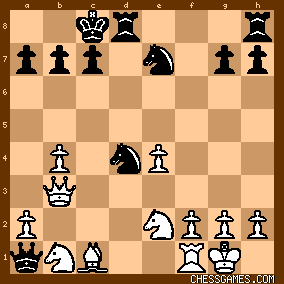| optimal play: <<<<CHESS IN SOUTH AUSTRALIA.> The subjoined is another specimen from the long series played by correspondence between Mr. Charlick and Mr. Mann, of South Australia.> (a) 3...♗b4+
The best move is 3... Kt to K B 3, but the play in the text has many recommendations. (b) 6.♕b3
Condemned by the authorities as enabling Black to preserve his Pawn with a good position, but neither 6. P takes B nor 6. B takes K B P (ch) leads to a favourable result for the first player. The former was thought to secure White a fine attack, but suppose-- 6. P takes B ; 6... Q takes R ; 7. Q to Kt 3 ; 7... P to Q 4 ; 8. B takes Q P ; 8... B to K 3 ; 9. B takes B ; 9... P takes B ; 10. Q takes P (ch) ; 10... Kt to K 2 ; 11. Q to Kt 3 ; 11... Q Kt to B 3 ; 12. Kt to K 2 ; 12... Castles Q R ; 13. Castles ; 13... Kt to Q 5 and Black's game is preferable. 6.cxb4 ♕xa1 7.♕b3 d5 8.♗xd5 ♗e6 9.♗xe6 fxe6 10.♕xe6+ ♘e7 11.♕b3 ♘bc6 12.♘e2 O-O-O 13.O-O ♘d4 
click for larger view(c) 9...♗b6
As the doubled Pawn in such a position would be rather advantageous to Black, the Bishop might have been left where he was, and 9... Kt to K 2 adopted instead. (d) 18...♖ae8
Black retains the Pawn with a perfectly safe position. Here, however, he ought to play Q R to Q sq. (e) 20...♖fe8
Pretty, but ill-judged. White, it is true, cannot win the Knight, but Black only saves it through the sequestration of his Queen and the general weakening of his game. 20... R to R 3 is good. In reply, White can only play P to K R 3 ;
for if 21. Kt to B 3 the answer Kt to Q 5 would win.
Black might then continue with Kt to R 5 threatening Kt takes Kt P. (f) 23...c5
A melancholy move, shutting out the Bishop. But half-a-dozen moves ago Black has the advantage; he has now no good play on the board. (g) 24...♕h4
If the Queen be not moved she will be cut off.
(h) 28.♘f6
The terminating moves are excellently played by White.> - The Australasian (Melbourne, Vic.) issue Saturday 28 May 1881> | 




